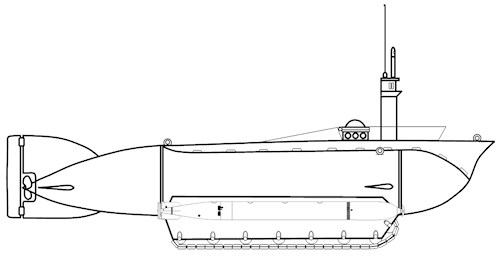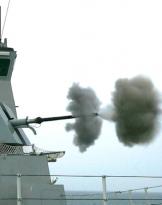Towards the end of the Second World War, the German navy hypothesized the development of an independent underwater boat, able to travel by land like any land vehicle, and then directly enter the water to carry out short attack missions, operating as a mini submarine. .
This project was assigned to the Torpedo Test Center of Kiel-Eckernförde who, under the guidance of Alois Lödige developed this decidedly innovative concept of an autonomous underwater vehicle called "Lödige Projekt" or monkfish (sea devil).
At the beginning of 1944 the development of a small size vehicle for amphibious use was hypothesized. Originally it was a defined mini boat sonderfahrzeug (special vehicle), piloted by a single man, about 9,8 meters long and weighing sixteen tons without armament, and armed with a pair of torpedoes positioned in the lower part of the hull near the tracks.
The prototype of the monkfish it was developed in four months and was ready for the first test in July. Unlike the initial design, it had a two-man crew and was lengthened to 14,2 meters, with a width of two meters. The displacement had risen to 35 tons.
The mini-submarine was powered by an 80 horsepower (60 kW) Otto petrol engine that provided propulsion both on the water and on the surface (about 10 knots) using a single propeller but also on land ensuring a speed of ten kilometers per hour.
Underwater it used a 25 horsepower (19 kW) AEG electric motor that had already been used successfully in the mini-submarine seal (next photo), which allowed a cruising speed of eight knots.

During the tests at sea the prototype proved to be able to operate at a maximum immersion depth of twenty-one meters (even if the target was 50 meters).
The autonomy on the surface at maximum speed was estimated, under standard conditions, to be thirty hours, extendable to eighty hours at a reduced speed. Dive: ten hours at maximum (electric) speed or twenty hours at patrol speed. This meant that its range of action from the ground could not have been significant, reducing its use to actions near the coast, always ensured by a logistic support for supply on land. A significant limitation.
The engine of the monkfish it was forward, directly under the fixed snorkel mast which also contained the periscope, a radio antenna and the magnetic compass. The control room was aft with a low-profile, and therefore difficult to discover, command tower in which the entrance hatch opened. The batteries and the fuel tank were in the center of the boat with the electric motor located in the stern.
The horizontal bow rudders were fixed, but the vertical rudder and the horizontal stern ones were governed by the navigator with a control stick similar to that used in the aeronautical field.
To compensate for the weight of the armament, the boat used a special ballast tank that prevented surfacing after the launch of the torpedoes. As for the armament, instead of the two torpedoes G7 could carry and release four mines. In amphibious use, that is, out of the water, he could use a flamethrower and a machine gun.
 Vizeadmiral (Vice Admiral) Hellmuth Heye, commander of the German Naval Special Forces stated in 1944: “I see the Seeteufel as a promising weapon for use in commando raids. It is independent of the mother ship and base personnel, can reach enemy coasts, commit acts of sabotage and evade pursuit on land or underwater. She can be brought to the site by a mothership equipped with a large crane. With an engine of more power than the prototype, a speed of 8 to 10 knots can be obtained. Speed and range could be further increased by installing a closed loop motor. Intended for use in coastal waters if time permits, on rivers, lakes and artificial lakes ... "
Vizeadmiral (Vice Admiral) Hellmuth Heye, commander of the German Naval Special Forces stated in 1944: “I see the Seeteufel as a promising weapon for use in commando raids. It is independent of the mother ship and base personnel, can reach enemy coasts, commit acts of sabotage and evade pursuit on land or underwater. She can be brought to the site by a mothership equipped with a large crane. With an engine of more power than the prototype, a speed of 8 to 10 knots can be obtained. Speed and range could be further increased by installing a closed loop motor. Intended for use in coastal waters if time permits, on rivers, lakes and artificial lakes ... "
Although early tests showed that the mini submarine could perform well underwater, it was considered undersized for land use. The tracks were too small and the vehicle was unstable and not very powerful on rough terrain or with loose sediments such as the sandy ones of a beach. In other words, it could have run aground and become stuck in enemy fire, losing its tactical advantage.
The use of more powerful 250 hp (190 kW) diesel engines was therefore envisaged, as well as wider tracks to distribute the load and reduce ground pressure. The prototype was presented to the management of the Borgward plant in Bremen and an initial production of three boats was initially envisaged to test the planned modifications. However, its tactical effectiveness would always be limited by its range of action and limited autonomy.
The decision of theOberkommando der Marine (High Naval Command) to concentrate production on the models already in production at the beginning of 1945, however, had these plans canceled and the only prototype made was then transferred to Lübeck and destroyed at the end of the war.
References
Kemp, Paul (1996). Underwater Warriors. London: Arms & Armor Press. ISBN 1-85409-228-6.
Mallmann Showell, Jak P. (2002). The German Navy Handbook, 1939–1945. Stroud, UK: Sutton Publishing. ISBN 0-7509-3205-8.
Moore, John & Compton-Hall, Richard (1987). Submarine Warfare: Today and Tomorrow. Bethesda, Maryland: Adler & Adler. ISBN 0-91756-121-X.
Prenatt, Jamie & Stille, Mark (2014). Axis Midget Submarines: 1939–45. Oxford, UK: Osprey Publishing. ISBN 978-1-4728-0122-7.
Rossler, Eberhard (2001). The U-Boat: The Evolution and Technical History of German Submarines. London: Cassell. ISBN 0-304-36120-8.
Photo: web / PimboliDD
(article originally published on https://www.ocean4future.org)












